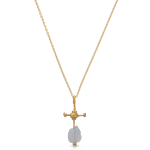

Byzantine
Gold and chalcedony cross pendant, Byzantine, circa 5th - 7th century AD
Gold, chalcedony
Length: 2.5 cm
Length of chain: 18 in (adjustable to 16 in)
Length of chain: 18 in (adjustable to 16 in)
A Byzantine gold cross with granulation and decorated with a chalcedony bead. The pendant is suspended from a modern 18 carat gold chain.
A Byzantine gold cross with granulation and decorated with a chalcedony bead. The pendant is suspended from a modern 18 carat gold chain.
Provenance
UK private collection, acquired in the 1980sLiterature
Despite the persistent anti-adornment attitudes in early Christian writings, the abundant material evidence speaks of the importance jewellery held for Byzantine women. Crosses ornamented with precious stones allowed the wearer to display both their faith and wealth. They also acted as protective amulets, as it was believed they could repel evil spirits.Cross pendants such as this example were most likely used to decorate large, elaborate necklaces, for an example, see The Metropolitan Museum of Art, New York, inv. no. 17.190.1667: K. Brown et. al., ed. From Attila to Charlemagne: Arts of the Early Medieval Period in the Metropolitan Museum of Art. New York and New Haven: The Metropolitan Museum of Art, 2000. p. 59, 341, fig. 7.1.

